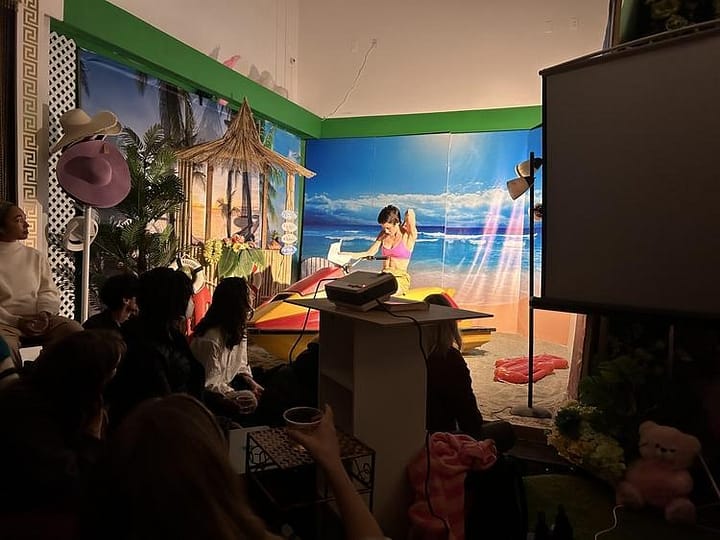SHORELINES
Place Settings
Los Angeles
Jan. 17, 2024
I was supposed to be in Jamaica this week, but I changed my mind.
There were many factors, but the biggest one came when a Jamaican Canadian friend shared an image on her Instagram story: a young boy riding a horse on a beach in Negril, Palestinian flag in hand. The caption said something about their struggles being intertwined. After some digging, I learned that local Jamaicans legally have access to less than one percent of their own beaches. The rest is largely the private property of foreign-owned entities.
Somehow, I still ended up on a beach.
Place Settings is “a site-specific experimental lecture series” held on photography sets around Los Angeles. A new tradition started last spring, the project has since hosted works like “communal luxury” in a glittering 17th-century-style parlor and “ascension” in a faux private jet.
The theme for this night was “shorelines.” When I arrived, I entered the back of a building from an alleyway near Pershing Square. The doorman told me to go up one floor. I began to worry if I wore the right shoes. But I had. I stood in a pair of dusty black boots, feet away from a hollow jet ski on a square of sand. We were in a kitschy photography studio with white and bubblegum-pink throne chairs, flower trellises in a garden, and a small beach. No water necessary.
Organizer Laura Nelson introduced me to co-conspirator Anya Ventura, and after a bit of mingling (as if on a real beach), it began. Our artist-guides were two researchers of the socioecological dimensions of shorelines: Maya Weeks, a geographer, writer, poet, and surfer; and Ayasha Guerin, an artist and scholar working on their first book, “connecting human and animal coastal experience through studies of colonialism, relational reciprocity, and survival.” These two were nothing short of perfect for this theme.
Maya went first. The room was so quiet that I could hear the tick of a wristwatch two seats away. Nearly 40 people were crammed into this studio, on the floor and in chairs, everyone very close to one another. Earlier, the person next to me had complimented my perfume. Maya wrapped a towel around her waist and began to change into beachwear. We were at the shore with her, just before she planned to surf. Suddenly, she ran toward the sand and jumped onto the jet ski. “I’ve been doing some real dumb girl shit lately,” she began. We listened to a tale of loss, of change, of nearly drowning — spliced with poetry. We rode the waves with her, holding our breath as they rose, exhaling as they fell.
For Ayasha’s part, silence was replaced by the hum of a projector as we watched and read to one another from the slides. Ayasha led us through a lecture weaving together themes from their first manuscript about “the impact of colonial conquest and slavery on coastal environments and communities.” They shared facts on pollution, protests, and war. They centered the work of journalists documenting gecocide.
Afterward, we sat with one another, taking in the weight of the performance and subsequent lecture. Intimacy defined. We discussed what we were sitting with: the roles we play in sustaining our coastlines; how to protect one another and our land; how to reconcile shorelines as sites of both pleasure and imperialism; and our futures, human and animal. It felt a bit like being back in college, which I appreciated at that moment. It made my concerns feel less frivolous, less lonely. If “we’re all islands shouting lies to each other across seas of misunderstanding,” then Place Settings bridged that gap, if only for a night.






